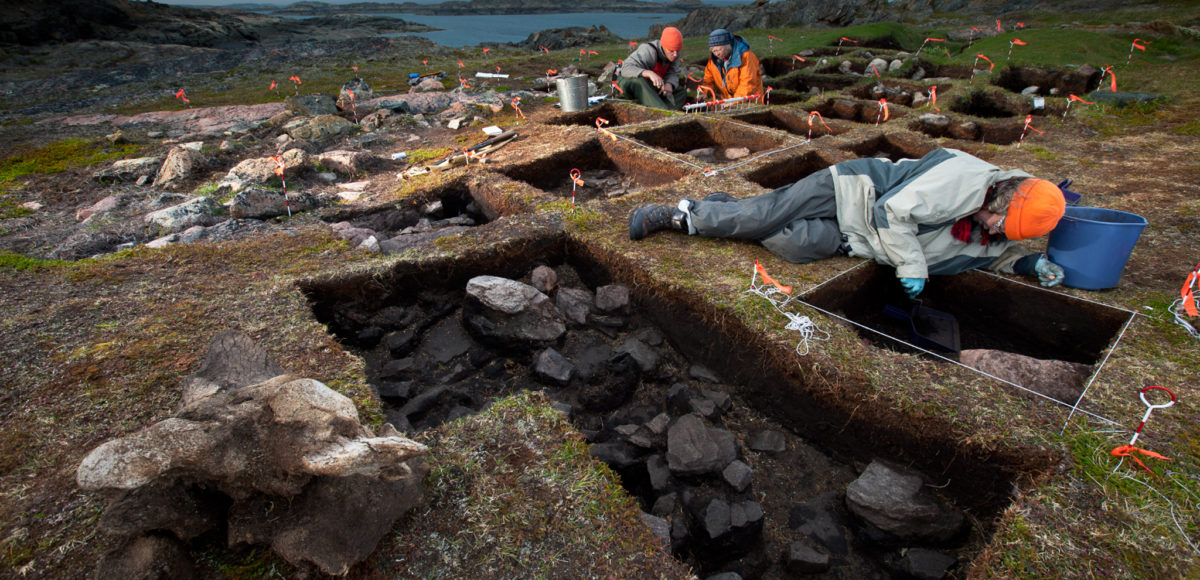A prominent Ottawa archaeologist credited in some circles with rewriting the history of Vikings in Canada has accused the Royal Ontario Museum in Toronto of “disparaging” her widely publicized research.
Patricia Sutherland is an adjunct professor at Carleton University and a former archaeologist with what was called the Canadian Museum of Civilization but is now the Canadian Museum of History.
While Sutherland worked at Civilization, the federal museum praised her ground-breaking research demonstrating there was contact up to 1,000 years ago between Greenlandic Vikings, later called the Norse, and the Dorset people, forerunners of the Inuit on Baffin Island. At the time of the museum’s 150th anniversary in 2006, the institution encouraged stories about her research. Scientific journals, the New York Times, National Geographic and other influential publications have since cited Sutherland’s work.

This Dorset carving of a human face is at the centre of debate over whether Vikings were in contact with people in Canada’s far north 1,000 years ago. Photo courtesy Royal Ontario Museum.
However, Sutherland was fired from the museum in 2012, allegedly for harassing co-workers, preventing her from continuing research into a number of artifacts found on Baffin that she claims demonstrate pre-Columbian contact by Indigenous people with the Norse. The museum continues to deny her access to the artifacts.
Meanwhile in Toronto, the ROM is exhibiting a turnkey show from Sweden called Vikings: The Exhibition, which focuses mainly on Viking exploration and conquests in Europe. The same exhibition was at the Canadian Museum of History in 2015-16.
The difference between the two iterations of the show is that the ROM’s version dives more into what is known as “Viking history” in Canada. In a video on the ROM website, the museum archaeologist in charge of the exhibition, Craig Cipolla, says the short-term Viking settlement in L’Anse aux Meadows in Newfoundland is the only “Viking history” in Canada. Such a statement seems to give no credence to the Baffin artifacts. But in an interview, Cipolla said the video should have stated that L’Anse aux Meadows is the only known “Viking settlement” in Canada.
In the Toronto exhibition, the ROM has borrowed some of the artifacts owned by the Canadian Museum of History that were found in Baffin Island and were key to Sutherland’s research into Viking-Dorset contact. But the ROM is treating the artifacts only as “possibly” revealing such contact.
Cipolla is not convinced, as Sutherland is, that there is evidence these artifacts prove the contact happened. He also doubts that there is firm evidence Nanook, an archeological site in Baffin where Sutherland has worked, contains the remains of Viking buildings. Sutherland does not call Nanook “a settlement” but “potential shore stations that would have been used for commercial hunting and/or trading.”
The loaned Baffin artifacts include a stone crucible containing bronze from a European source, wooden tally sticks typically used by the Norse in trade transactions, two whetstones typical of those used by the Norse for sharpening metal tools and two antler pieces with carved faces, one representing a Dorset-like person and the other resembling a European.
That latter artifact is what Sutherland calls “the icon piece” for the “Helluland Project.” (Helluland is the name Vikings gave to Baffin Island.) But Cipolla says claiming the carved face is European is simply a “subjective” reading. He also questions the stone crucible with bronze as being proof of anything as it is impossible to certify the age of the object. Furthermore, Cipolla claims only a minority of archeologists agree with Sutherland’s interpretation of the artifacts.
Sutherland notes that Cipolla’s expertise is in the Indigenous archaeology of New England and the Great Lakes and not with the Norse: “It seems curious that he would want to include the Helluland artifacts in the exhibit, while at the same time denying their authenticity and stating that ‘L’Anse aux Meadows is the only firm evidence that Canada has a Viking history.’ On the other hand, the situation has provided the Canadian Museum of History with an excuse to, at a minimum, delay my request to continue research on this material, while at the same time having my work disparaged in the largest Canadian museum market.”
So, does the Canadian Museum of History support the views of Sutherland or the ROM? The answer is complicated. After several days of badgering the Gatineau museum for comment, these carefully worded statements were offered by Patricia Lynch, director of corporate affairs.
“L’Anse aux Meadows is the only recognized Viking site in North America,” Lynch said in an email. “However, we do know that evidence for a Viking presence, or their material culture, through trade or other means, has been found in other locations.
“With regards to the Helluland Archaeology Project … important material was gathered and significant research done, which hold great promise regarding the ongoing question of a Viking presence in North America. The museum remains proud to have financed and supported the Helluland Project and the exciting research that suggests, but does not prove conclusively, longer-term contact between European and Indigenous peoples in the Arctic.”







